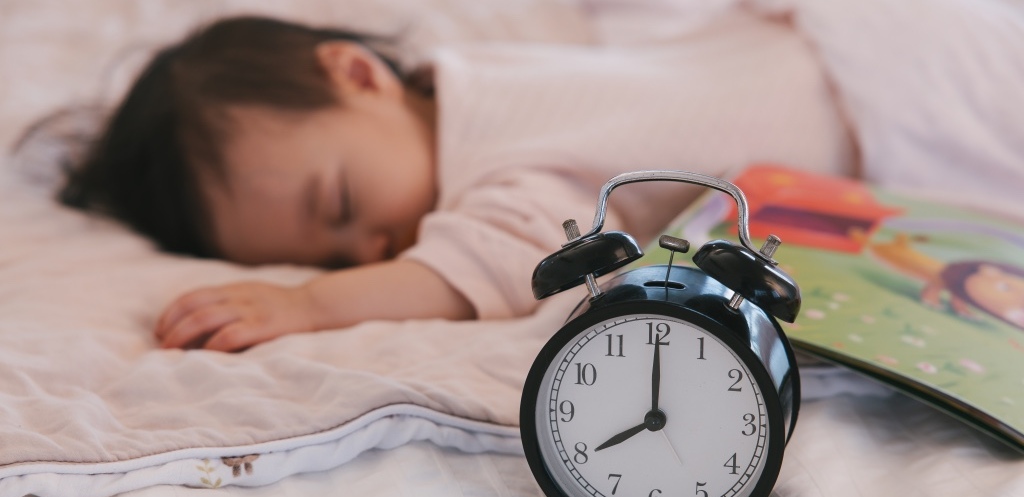Table Of Contents
- Introduction to the 6 Month Old Sleep Routine
- Understanding How Much Sleep a 6-Month-Old Needs
- Creating the Perfect Baby Sleep Routine (6 Months)
- Common Sleep Challenges and Regressions
- Tips for Sleep Training a 6-Month-Old
- Night Routine for 6-Month-Olds: Step-by-Step
- FAQs About the 6 Month Old Sleep Routine
At Mumzworld, we know how precious rest is, for both parents and babies. By the age of six months, your little one’s sleep habits start to stabilize, making it the perfect time to establish a consistent 6 month old sleep routine.
A well-planned baby sleep routine (6 months) promotes longer nighttime rest, smoother naps, and happier days. Around this age, your baby’s sleep patterns become more predictable, giving you the chance to implement structure while still staying flexible to their unique needs.
By six months, most babies begin to sleep for longer stretches at night and take fewer naps during the day. However, challenges such as baby sleep regression at 6 months, baby fighting sleep, or baby waking up at night are also common. The goal is not perfection but progress, helping your baby develop healthy habits that lead to peaceful nights and energetic days.
Understanding How Much Sleep a 6-Month-Old Needs
Before creating your 6 month old sleep routine, it’s essential to understand your baby’s sleep requirements. On average, a six-month-old needs 13 to 15 hours of sleep every 24 hours, divided between nighttime sleep and daytime naps.
- Nighttime Sleep: 10–11 hours (possibly with one night feeding).
- Daytime Naps: 2–3 naps totaling 3–4 hours.
These numbers may vary depending on your baby’s temperament, feeding pattern, and overall development. Some babies start sleeping through the night at this age, while others still need a nighttime feed.
Six Month Old Wake Windows
A key part of the 6 month old sleep routine is managing wake windows, the time your baby stays awake between naps. At six months, most babies can handle about 2–3 hours of awake time. Exceeding this window often leads to baby fighting sleep or overtiredness.
Here’s an example:
- Morning wake-up: 7:00 AM
- Nap 1: 9:00 AM (1.5 hours)
- Nap 2: 12:30 PM (1.5 hours)
- Nap 3: 4:00 PM (30–45 minutes)
- Bedtime: 7:00 PM
This 6-month-old nap schedule helps balance awake time with rest, ensuring your baby doesn’t get overstimulated.
Signs Baby Is Tired (6 Months)
Recognizing the signs your baby is tired makes it easier to stick to a consistent 6 month old sleep routine. Watch for:
- Rubbing eyes or ears
- Yawning frequently
- Losing interest in toys
- Becoming clingy or fussy
- Slow or jerky movements
Putting your baby to bed as soon as these signs appear helps avoid overtiredness, which can make it soothing a baby to sleep much harder.
Creating the Perfect Baby Sleep Routine (6 Months)
A successful infant bedtime routine prepares your baby for sleep both physically and emotionally. It’s not just about the clock. It’s about creating cues that signal rest time.
1. Consistent Bedtime
Choose a bedtime that aligns with your family’s schedule but keep it consistent, usually between 6:30 and 8:00 PM. Consistency is crucial in any baby sleep routine (6 months).
2. Calm Environment
Create a peaceful space. Dim the lights, use white noise, and ensure the temperature is comfortable. These small details can drastically improve your 6 month old sleep routine.
3. Predictable Steps
Your night routine for 6-month-olds could include:
- A warm bath
- Gentle massage with baby lotion
- Soft lullabies or bedtime story
- Quiet feeding
- Placing baby in the crib drowsy but awake
This sequence helps signal that it’s time to wind down.
4. Encourage Self-Soothing
At this age, babies can begin learning how to fall asleep independently. This doesn’t mean leaving them alone immediately, it means gradually encouraging them to settle with minimal help. You can use gentle sleep training for babies to help them develop these skills.
Common Sleep Challenges and Regressions
Even with the best 6 month old sleep routine, you may face obstacles. Understanding these challenges helps you navigate them calmly.
Baby Sleep Regression (6 Months)
Sleep regression happens when your baby suddenly starts waking more often at night or resists naps. Around six months, this can occur due to rapid development, teething, or learning new skills like rolling or sitting.
Tips:
- Stick to your 6-month-old sleep schedule even if naps shorten temporarily.
- Offer comfort but avoid forming new sleep crutches.
- Be patient, it usually passes in 2– 4 weeks.

Baby Not Sleeping at 6 Months
If your baby is not sleeping at 6 months, consider these possibilities:
- Overstimulation before bedtime
- Late naps or irregular schedule
- Hunger (try adjusting feeding times)
- Growth spurts or teething discomfort
Regular bedtime rituals and a steady infant bedtime routine often help restore balance.
Baby Waking Up at Night
Frequent night wakings are normal but can be reduced. Try:
- Short nighttime interactions (dim lights, no play).
- Ensuring full feedings during the day.
- Avoiding overtiredness by respecting wake windows.
Remember, each baby’s 6 month old sleep routine may vary slightly, flexibility is key.
Tips for Sleep Training a 6-Month-Old
By six months, many babies are ready for gentle sleep training. This helps them learn how to sleep independently and reduce night wakings.
Gentle Sleep Training for Babies
This method focuses on gradual changes rather than abrupt crying sessions.
- Put your baby to bed while drowsy but awake.
- Offer comfort through touch or voice instead of immediate pickup.
- Slowly increase the time before responding to cries.
This approach respects both your baby’s need for security and your goal for longer sleep stretches.
Cry It Out Method (6 Months)
Some parents choose a more structured method like cry it out. While controversial, some find it effective if done safely.
- Always ensure your baby is well-fed, dry, and comfortable.
- Set a time limit before checking in.
- Stay consistent, mixed messages confuse babies.
Whichever method you choose, the key is consistency and calm reassurance. Over time, your 6 month old sleep routine will become second nature.
Night Routine for 6-Month-Olds: Step-by-Step
A soothing night routine for 6-month-olds encourages longer, uninterrupted sleep. Here’s an example from Mumzworld’s recommended approach:
- Evening Wind Down (6:00 PM): Turn off bright lights and reduce noise.
- Warm Bath (6:15 PM): Helps relax muscles and signal bedtime.
- Massage and Pajamas (6:30 PM): Gentle massage improves circulation and bonding.
- Feeding (6:45 PM): Offer a calm final feed to ensure fullness.
- Story or Lullaby (6:55 PM): A comforting routine that enhances emotional security.
- Lights Out (7:00 PM): Place your baby in a safe crib, drowsy but awake.
This pattern aligns with safe sleep principles, no loose bedding, soft toys, or pillows. Prioritize safe sleep for infants by always placing your baby on their back and ensuring a firm mattress.
Tips for Sleep Training a 6-Month-Old
To summarize, here are the best 6-month-old sleep tips for success:
- Maintain consistent bedtime and wake times.
- Respect 6-month-old wake windows to avoid overtiredness.
- Watch for early signs that the baby is tired (6 months).
- Follow a structured infant bedtime routine.
- Stay calm and patient, habits form over time.
The journey toward restful nights takes practice. But with patience, your 6 month old sleep routine can transform bedtime into a peaceful family ritual.
FAQs About the 6 Month Old Sleep Routine
- How much sleep does a 6-month-old need?
A 6-month-old typically needs 13–15 hours of sleep daily, about 10–11 at night and 3–4 in naps. - Why is my baby not sleeping at 6 months?
Common causes include growth spurts, teething, or overstimulation. Adjust your 6 month old sleep routine and maintain consistency. - When do babies start sleeping through the night?
Many start around six months, though it varies. Some may still need one nighttime feeding. - What if my baby keeps waking up at night?
Ensure your 6-month-old nap schedule isn’t too long and avoid late naps. Gentle reassurance and routine adjustments often help. - How can I make bedtime easier?
Create a calm, predictable night routine for 6-month-olds: bath, massage, feeding, lullaby, then bed. - Is sleep training safe for 6-month-olds?
Yes, gentle sleep training for a 6-month-old can be safe if your baby is healthy and gaining weight well. - What are signs my baby is ready to drop a nap?
Consistent refusal of one nap or longer wake times between naps indicates readiness to adjust the baby sleep routine (6 months). - How can I soothe my baby to sleep naturally?
Use soft music, gentle rocking, and a peaceful environment to promote soothing a baby to sleep naturally. - What should I avoid during bedtime?
Avoid screens, loud noises, or overstimulating play before bed. These disrupt the 6 month old sleep routine. - What’s the safest sleep position for infants?
Always place your baby on their back on a firm mattress for safe sleep for infants.
Conclusion
Creating a structured 6 month old sleep routine takes time, but the rewards are invaluable, a well-rested baby and calmer parents. With consistency, patience, and gentle guidance, your little one will learn to associate bedtime with comfort and security.
From understanding how much sleep a 6-month-old needs to managing baby sleep regression at 6 months, every step contributes to healthier sleep habits.
Remember, each baby is unique. Follow your instincts, adapt to your child’s cues, and use these 6-month-old sleep tips to craft a nurturing routine.
For all your sleep essentials, swaddles, white noise machines, and soothing bedtime must-haves, explore Mumzworld, your trusted parenting partner.
Selected Products to Support Your Motherhood Journey from Mumzworld
Because Mumzworld brings together trusted global brands in one place, you can explore a variety of products that make your parenting journey easier and more comfortable, including:
- Baby Monitor to keep track of your little one’s safety.
- Breast Pumps to support and simplify breastfeeding.
- Baby Bottles designed for safe and easy bottle-feeding.
- Diaper Bags for convenient movement when outside the home.
- Disposable Diapers for comfort and ease during travel and daily activities.






